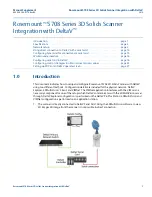
Chapter 2
Menu Configuration
2-6
MS-610 Scanner User’s Manual
2–Menu Conf
ig.
Host Protocol
Protocol
Default: Point-to-Point
Options: Point-to-Point, Point-to-Point with RTS/CTS, Point-to-Point with
XON/XOFF, Point-to-Point with RTS/CTS & XON/XOFF, Polling
Mode D, User Defined, User Defined Multidrop
Protocols define the sequence and format in which information is trans-
ferred between devices.
Selecting:
Has this effect:
Point-to-Point
Has no address and sends data to the host (RS-232)
whenever it is available and without any request or
handshake from the host.
Point-to-Point with
RTS/CTS (Request-
to-Send/Clear-to-
Send)
Used only with RS-232. This is a simple handshaking
protocol that allows a device to initiate data transfers to
the host with an RTS (request-to-send) transmission.
The host, when ready, responds with a CTS (clear-to-
send) and the data is transmitted. CTS and RTS
signals are transmitted over two dedicated wires (pins
6 and 10) as defined in the RS-232 standard.
Point-to-Point with
XON/XOFF
(Transmitter On/Off)
Used only with RS-232. This selection enables the host
to send a single byte transmission command of start
(XON) or stop (XOFF). If an XOFF has been received
from the host, data will not be sent to the host until the
host sends an XON. During the XOFF phase, the host
is free to carry on other chores and accept data from
other devices.
Point-to-Point with
RTS/CTS & XON/
XOFF
Used only with RS-232. It is a combination of Point-to-
Point with RTS/CTS and Point-to-Point with XON/
XOFF.
Polling Mode D
Like Point-to-Point, Polling Mode D requires a separate
channel to the host but unlike Point-to-Point, it requires
a device to have an address and to wait for a poll from
the host before sending data.
When in Polling Mode D, an address 1 is automatically
displayed on the configuration screen. However, during
transmission, a 1C hex poll address (FS) and a 1D hex
select address (GS) are substituted for the 1.
















































